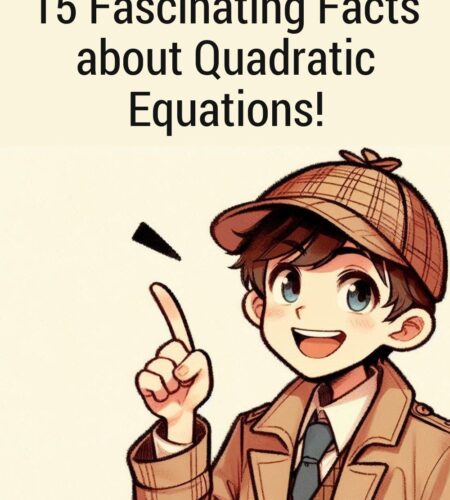Introduction:
Quadratic equations are a fundamental concept in mathematics that has fascinated people for centuries. These equations, which involve an unknown variable raised to the power of two, have a range of applications in fields such as physics, engineering, and computer science. In this article, we will explore 15 fascinating facts about quadratic equations that will not only increase your knowledge but also spark your curiosity about the mathematical world.
Fact 1: The General Form of a Quadratic Equation
A quadratic equation is generally expressed in the form of ax^2 + bx + c = 0, where “a,” “b,” and ”c” are constants, and “x” is the unknown variable. The coefficient “a” cannot be zero, as it determines the nature of the equation.
Fact 2: The Existence of Real Solutions
One intriguing fact about quadratic equations is that they always have either two distinct real solutions, one real solution (known as a repeated root), or no real solutions at all. The nature of the solutions depends on the discriminant (b^2 – 4ac). If the discriminant is positive, there are two real solutions; if it is zero, there is one repeated real solution; and if it is negative, there are no real solutions.
Fact 3: Real-World Applications
Quadratic equations are not mere abstract concepts; they have practical uses in various fields. For example, in physics, these equations are employed to analyze motion, calculate trajectories, and predict the behavior of objects under the influence of gravity.
Fact 4: The Quadratic Formula
The quadratic formula is a powerful tool that allows us to find the solutions of any quadratic equation. It states that the solutions, or roots, of a quadratic equation can be found using the formula: x = (-b ± √(b^2 – 4ac))/2a. This formula is derived by completing the square.
Fact 5: Connection to Parabolas
Quadratic equations are intrinsically linked to parabolas, which are symmetrical U-shaped curves. The graph of a quadratic equation always forms a parabola, and the properties of the equation directly affect the properties of the corresponding parabola.
Fact 6: The Vertex
The vertex is a crucial concept associated with quadratic equations and parabolas. It represents the highest or lowest point of the parabola, depending on whether it opens upwards or downwards. The vertex can be found using the formula x = -b/2a for the x-coordinate and substituting it back into the equation to obtain the y-coordinate.
Fact 7: Quadratic Regression
Quadratic regression is a statistical technique that uses quadratic equations to model and analyze data. It is particularly useful when examining non-linear relationships between variables and can provide valuable insights into various real-world phenomena.
Fact 8: Historical Significance
Quadratic equations have a rich historical background. They were extensively studied by ancient mathematicians such as Babylonians, Egyptians, and Greeks, who recognized their significance and made significant contributions to their understanding.
Fact 9: Role in Calculus
Quadratic equations serve as a foundation for calculus, a branch of mathematics that deals with change and motion. Calculus applies quadratic equations to study rates of change, optimize functions, and solve complex mathematical problems.
Fact 10: Pythagorean Triples
Pythagorean triples are sets of three positive integers that satisfy the Pythagorean theorem. It is intriguing to note that many Pythagorean triples emerge from quadratic equations, further emphasizing their importance and connection to geometry.
Fact 11: Complex Solutions
Quadratic equations can have complex solutions when the discriminant is negative. Complex solutions involve the imaginary unit “i,” and they exist in a complex number plane. They play a vital role in electrical engineering and quantum mechanics.
Fact 12: Role in Computer Graphics
Quadratic equations find applications in computer graphics, where they are used to generate curves and shapes. By altering the coefficients and constants in the equation, various visually appealing designs can be created.
Fact 13: Quadratics and Quadratic Systems
Quadratic systems involve the simultaneous solving of multiple quadratic equations. They are utilized in optimization problems, economics, physics, and engineering, helping to find the optimal values that maximize or minimize certain quantities.
Fact 14: Quadratic Equations in Music
Believe it or not, quadratic equations are relevant even in the realm of music! Some musical compositions, particularly in the Baroque and Classical eras, incorporate quadratic equations and curves to create pleasing melodies and harmonies.
Fact 15: Unresolved Mathematical Conjectures
Despite extensive research and progress in the field of quadratic equations, certain conjectures still remain unsolved. One such example is the Collatz Conjecture, which poses a question about the behavior of a specific sequence generated by repeatedly applying a quadratic equation to a given number.
Conclusion
Quadratic equations are not just abstract mathematical concepts but intriguing tools that have far-reaching applications. From their real-world significance to their historical importance and their involvement in diverse fields, quadratic equations continue to captivate mathematicians and scientists alike. By delving into these 15 fascinating facts, we have only scratched the surface of the immense depth and complexity of quadratic equations. So, let us embrace the enigma of these equations and appreciate their beauty in both theory and practice.
Subscribe to our email newsletter to get the latest posts delivered right to your email.




Comments